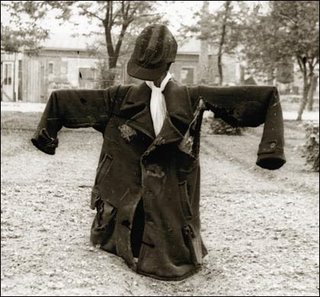From the Western Front trenches of World War I to the deserts of Iraq, soldiers have found comfort in the simple act of gardening.Kenneth Helphand, writes about war gardens -- not just victory gardens, grown in time of scarcity, but those planted on hostile fronts, including Poland's ghettos and the Japanese-American internment camps of WWII in his cool new book.
Helphand calls such gardens an act of defiance.

(NPR)--
Helphand's fascination with what he now calls "defiant gardens" began with this undated World War I photograph (click to enlarge) of soldiers in the French trenches flanked by their planting beds. Notice the use of twigs as ornamental borders delineating each soldier's plot. Helphand had this picture on his bookshelf for several years before deciding to pursue the meaning of gardens in such extreme circumstances, beyond their obvious use for food.


From World War II, there were graphic and emotional accounts of subsistance plots in Nazi ghettos (see pics, above) as well as rock garden taupiaries in the Japanese internment camps in the American west (see pic below.)
The Polish ghettos created by the Nazi during World War II were "urban prisons," writes Helphand, "set up to deliver their residents, ultimately, to extermination." (NPR)--
Those residents, Polish Jews, were walled or fenced in to restricted areas, as they were in the Glubokoye ghetto, pictured above. Here, residents are working in a plant nursery in what might have been a moment of respite, at least distraction. From this community of 6,000, about 60 are thought to have survived. Gardens in the ghetto were literally carved out of dust and rubble, as shown here in this picture from the Lodz Ghetto.Note the star of David on the scarecrow. Chilling, indeed.
 Worlds away from the ghetto, in a landscape unimaginable to Polish Jews, another community was corralled involuntarily: Americans who were Japanese. This Stonehenge-like arrangement is actually the mess hall garden created at the Manzanar Internment Camp, from rocks and boulders dug out of the surrounding California desert.
Worlds away from the ghetto, in a landscape unimaginable to Polish Jews, another community was corralled involuntarily: Americans who were Japanese. This Stonehenge-like arrangement is actually the mess hall garden created at the Manzanar Internment Camp, from rocks and boulders dug out of the surrounding California desert.The American soldiers in the Perian Gulf have also lent their green thumb to otherwise bleak surroundings. (see pics)

 Left photo: U.S. Army Warrant Officer Brook Turner trims his grass with scissors in a camp north of Baghdad in July 2004. He missed the green of Hawaii, where he lives, and of his native Oregon. His wife sent him grass seed, but ants ate it. Undeterred, he acquired sod.
Left photo: U.S. Army Warrant Officer Brook Turner trims his grass with scissors in a camp north of Baghdad in July 2004. He missed the green of Hawaii, where he lives, and of his native Oregon. His wife sent him grass seed, but ants ate it. Undeterred, he acquired sod.Right image:Stationed outside Tikrit, Iraq, Army Sgts. Justin Wanzek (left) and Carl Quam Jr. (featured in our story) borrowed Iraqi irrigation and planting techniques and grew bumper crops of food: corn, cauliflower, cucumbers and peas. Their battalion ate particularly well, but that was only part of Quam's motivation. Gardening was a way to connect to his home in North Dakota: "It helped me cope with missing them."

8 comments:
I clicked on the NPR link and listened to the 2 minute story which inspired this entry.
I remember that photo of the soldier with his little plot of grass.
Nice post.
Incredible photos, thanks.
Wow very interesting story and pics. Thanks for your work and link. I had no idea.
Onanite
Great story...and pics. I never knew about gardening and the troops. It's very touching.
What an incredible and profound story. It should be publicized everywhere and give people cause to stop and think.
Wow. I have never ever heard of this. Great post, Jay.
Very sweet. Thanks for sharing that :D
Post a Comment